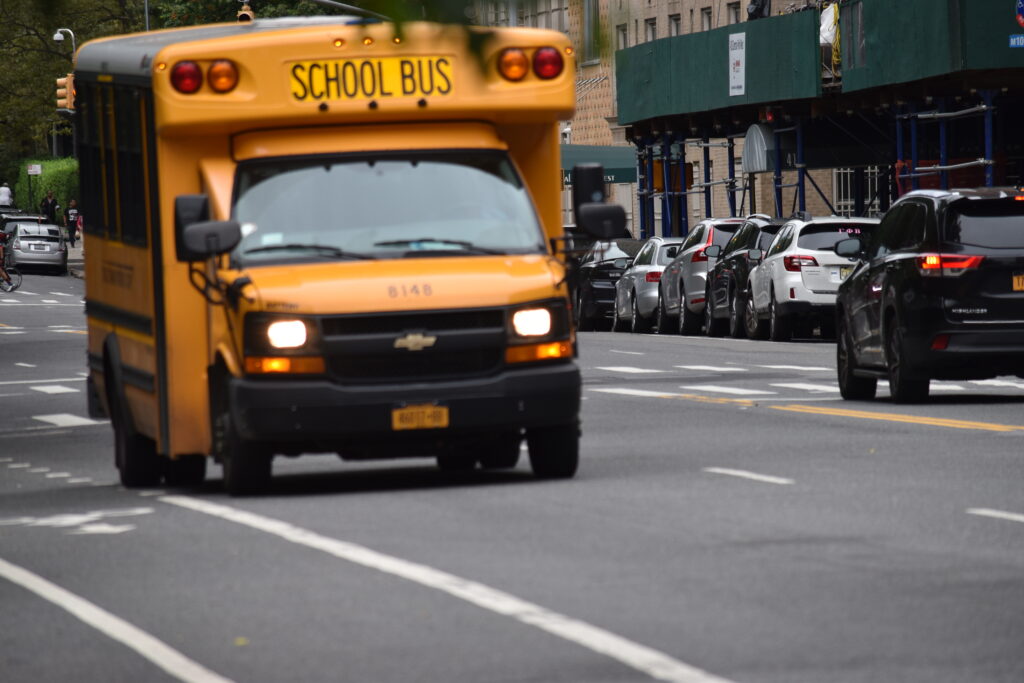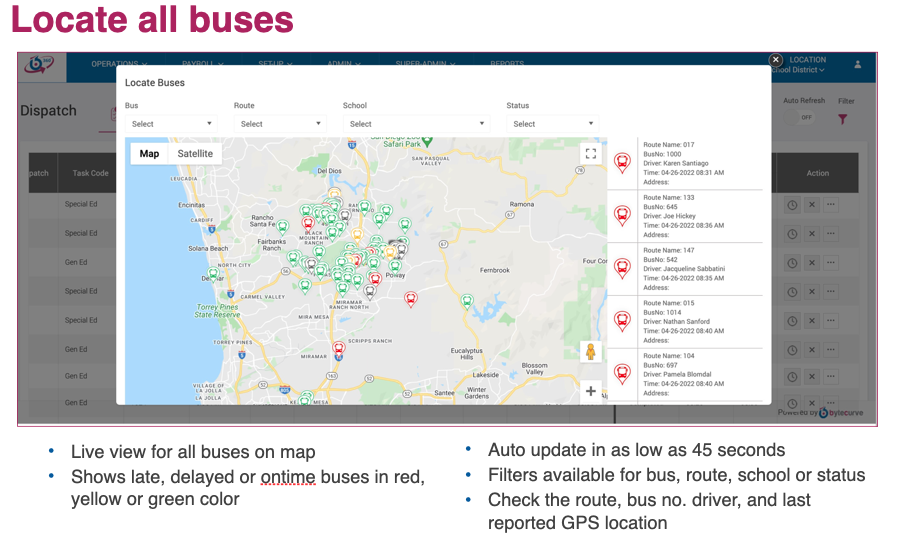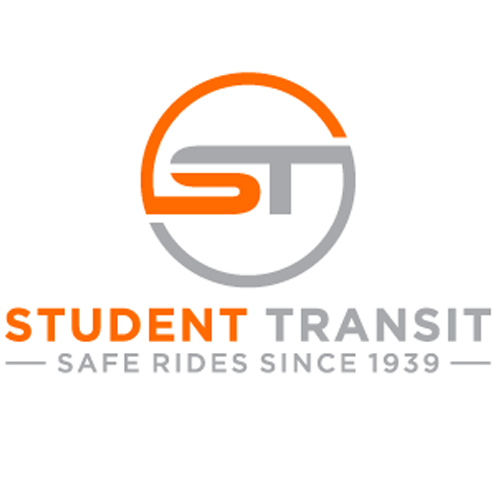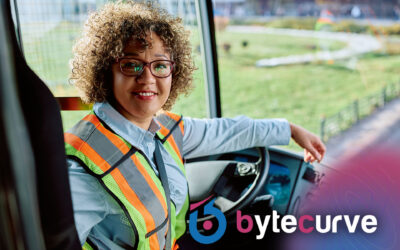BYTECURVE RESOURCES
Wi-Fi-Enabled School Buses
Connecting Students and Drivers to Learning and Efficiency
“Bytecurve makes our payroll process seamless with reduced time and paperwork,”
-Jennifer Idlette, Transportation Director, Indian River School District
Buses Served
Districts and Contractors
Payroll Processed
Wi-Fi-Enabled School Buses
When is a school bus not just a mechanism for shuttling children between their home and school each day?
When it’s connected to the internet.
Modern school buses are evolving beyond their traditional role of transporting students to and from school.
Many school districts are now investing in advanced technology to boost student learning, enhance safety, and improve operational efficiency, leading to significant cost savings.
A few years ago, the Vernon Verona Sherrill Central School District (VVSCSD) in New York took a step forward by outfitting their buses with Wi-Fi.
This initiative has allowed students to remain engaged with their schoolwork while commuting, whether they are heading home or traveling to extracurricular events, says Mark Wixson, the district’s assistant superintendent for finance and operations.
“Providing students with more opportunities to stay engaged in their education beyond school hours is always beneficial,” Wixson said.
Meanwhile, the Canyons School District in Utah has implemented vehicle telematics systems on their buses. These systems, equipped with GPS, cameras, and sensors, allow school administrators to track and manage their bus fleets more effectively.
With telematics, drivers receive precise GPS-guided directions, ensuring they take the safest and most efficient routes. This results in improved punctuality and reduced fuel costs.
Transportation officials can monitor bus locations in real time, assess vehicle performance, and analyze driving behavior, including speed and braking habits.
By leveraging this data, school districts can optimize daily transportation operations, conduct preventative maintenance, and provide drivers with performance feedback.
The cameras also serve as valuable tools for reviewing incidents, whether for accident investigations or addressing concerns raised by the public.
“From an operational perspective, it’s an essential tool that we rely on daily,” Jeremy Wardle, Canyons School District’s transportation director, told EdTech magazine.
The Federal Communications Commission recently ruled that Wi-Fi on school buses qualifies for E-Rate funding, making it more accessible to school districts.
However, Vernon Verona Sherrill Central Schools took the initiative back in 2021, utilizing the Emergency Connectivity Fund to install Wi-Fi on their 33 buses and provide additional Chromebooks for students.
With existing Cisco Wi-Fi infrastructure in place across its schools, the district chose Kajeet’s routers for its buses, as they were specifically designed for student transportation. Kajeet installed the equipment over the district’s spring break that year, according to Wixson.
Even though the vast majority of students have home internet access, the district still provides Wi-Fi hotspots for those who do not. Wixson believes school bus Wi-Fi serves as an additional resource to close the digital divide.
Wi-Fi access on buses has two primary benefits: It keeps students engaged in their education while in transit and encourages better behavior.
With most students living within a short drive of their schools—the longest ride lasting about 30 minutes—Wi-Fi access ensures they can make productive use of their time.
“Having a device in hand and access to educational content, including instructional videos and academic games, gives students something engaging to focus on, which in turn leads to better behavior on the bus,” Wixson explained to EdTech.
Students are already taking full advantage of the Wi-Fi, using their Chromebooks for assignments, research, and school projects.
“It helps with time management,” Wixson adds. “After a game, they don’t have to wait until they get home to start their homework.”
Kajeet’s routers connect to a 4G LTE network, with the Wi-Fi password displayed on a sign at the front of the bus. The district employs Lightspeed for web filtering, ensuring students only access appropriate online content.
Initially, VVSCSD used Emergency Connectivity Fund money to cover the cost of the equipment and service. In subsequent years, the district has purchased its data plan through the Mohawk Regional Information Center, which allows the state to subsidize almost 80% of the cost.
Wixson notes that the system has been highly reliable, stating, “We haven’t experienced any issues—it’s been dependable.”
Wi-Fi Expands Learning for Students in Rural Areas
As we’ve discussed, the implementation of Wi-Fi on school buses significantly transforms student learning.
In areas with limited broadband connectivity, many districts struggle to ensure that all students have equal access to educational resources.
By equipping buses with internet access, schools can help bridge this gap and provide students with more opportunities to engage with their coursework outside the classroom.
“As in many other sectors, the Internet of Things (IoT) has been a boon for education,” reported Built In, an online community for startups and tech companies. ”From so-called ‘flipped classrooms’ and online courses to integrated mobile technology and more efficient teaching methods, IoT-enabled connectivity continues to supplant pencils, paper, and chalkboards as instructional approaches and learning opportunities expand.”
For students involved in extracurricular activities or those with long commutes, the ability to access online assignments, conduct research, or collaborate with classmates in real time is invaluable.
Smart buses create an environment where learning doesn’t have to stop when the school day ends.
Teachers can assign digital coursework knowing that students will have an opportunity to complete their work even if they lack home internet access.
Smart buses provide opportunities for interactive engagement in addition to traditional learning.
Schools can implement educational programs that leverage digital tools to enhance student productivity during transit.
Whether students are accessing digital textbooks, watching instructional videos, or participating in virtual tutoring sessions, Wi-Fi-enabled school buses provide an essential extension of the classroom.
Here are some of the ways that smart buses provide learning opportunities for students:
- Enable access to online assignments and research materials
- Support digital collaboration and virtual tutoring
- Provide interactive educational content during transit
- Bridge the digital divide for students with limited home internet access
- Allow for extended learning opportunities beyond classroom hours
Farmington Municipal Schools in New Mexico has also seen significant benefits from Wi-Fi-enabled buses, EdTech reported.
The district first introduced Kajeet routers on nine buses in 2020 and, due to their success, expanded Wi-Fi coverage to all 90 buses the following year.
Covering a vast 808-square-mile area, the district transports around 6,500 students daily, many of whom have long commutes. Some students travel up to two hours to reach school, and for those involved in after-school sports, trips to games can take three hours or more.
Given these circumstances, Wi-Fi connectivity on school buses is essential. Middle and high school students in the district use laptops, while elementary students are provided with tablets. Funding for the initiative has come from multiple sources, including Title I funds, ESSER relief funds, and now E-Rate grants.
Parents appreciate the benefits as well, sharing that their children often complete their homework before arriving home.
“Our buses have essentially become extensions of the classroom,” Billy Huish, the district’s transportation supervisor, said. “Students aren’t just riding home after school; they’re continuing their education on the bus.”
WiFi Also Improves Vehicle Efficiency
The integration of Wi-Fi-enabled technology into school buses is truly transforming student transportation.
More than just a means of travel, smart school buses are now mobile learning environments that allow students to remain connected to their education while on the move.
At the same time, these advancements equip drivers and transportation administrators with critical tools to optimize routes, enhance safety, and maintain vehicle efficiency.
Wi-Fi-enabled school buses are bridging the digital divide by providing students with access to online learning resources during their commutes.
This connectivity is particularly beneficial for students in rural or underserved communities who may not have reliable internet access at home.
By enabling students to complete homework, study, or engage in digital learning platforms while traveling, school districts are maximizing the use of time that was previously unproductive.
Smart bus technology is not only benefiting students but also revolutionizing the management of school transportation.
Here are some of the ways smart buses improve efficiency for transportation leaders and drivers:
- GPS tracking for real-time location monitoring and route adjustments
- Automated route optimization to reduce delays and fuel consumption
- Live updates for traffic, weather, and emergency notifications
- Driver behavior analytics to improve safety and efficiency
- Enhanced communication between drivers and dispatch centers
Advanced software solutions like Bytecurve360 provide school districts with valuable insights into fleet performance, driver behavior, and overall operational efficiency.
These systems help reduce costs, improve safety, and ensure that buses remain in top condition for daily use.
As the only software solution that merges GPS Fleet Tracking and routing data into a new solution, Bytecurve360 is the fastest-growing technology serving the student transportation industry thanks to its ability to significantly improve:
- Payroll operations, including the streamlining of different pay codes and jobs or tasks between and among staff members
- Dispatching operations, including the ability to alter routes, runs and tasks in real-time to respond to later and/or absent drivers
- Real-time app-powered communications, including the ability for drivers in the field to respond to route changes via the app
Bytecurve, for instance, delivers an entirely new scheduling and dispatch experience that will transform the way your team manages routes, tasks, and chronic driver shortages.
Trusted by dozens of districts across North America, more than 40,000 school buses rely on Bytecurve technology to improve their efficiency and safety.
By merging data from routing and GPS fleet tracking, Bytecurve users see new opportunities to enhance operations and improve safety.
Bytecurve provides the following capabilities and features:
- Create and maintain annual schedules
- Manage daily schedule changes
- Monitor daily dispatch with real-time status alerts
- Track on-time performance at stops and schools
- One-click guarantee and overtime calculations
- Produce time and attendance records for export to payroll system
- Single view into planned vs. actual route data
Optimizing Driver Performance and Safety
While student learning benefits are a crucial component of smart bus technology, drivers also gain significant advantages from these innovations. GPS tracking, real-time traffic updates, and automated route optimization enable drivers to perform their jobs more effectively, reducing delays and improving overall transportation efficiency.
Advanced fleet management systems like Bytecurve360 provide real-time data on driver behavior, helping administrators monitor safety metrics such as speed, braking patterns, and idle times.
Transportation managers can use this information to pinpoint areas for improvement, provide tailored driver training, and guarantee consistent adherence to safety protocols.
Wi-Fi connectivity also enhances communication between drivers and dispatch centers. Instant updates on route changes, road conditions, and weather alerts allow for quick decision-making, reducing the likelihood of delays or disruptions.
Drivers can receive immediate guidance if a detour is necessary, ensuring that students arrive at their destinations safely and on time.
Furthermore, smart bus technology includes security features such as interior and exterior surveillance cameras, student tracking systems, and emergency alert capabilities.
These tools not only improve passenger safety but also provide school districts with documented evidence in case of incidents, allowing for swift resolution of any concerns.
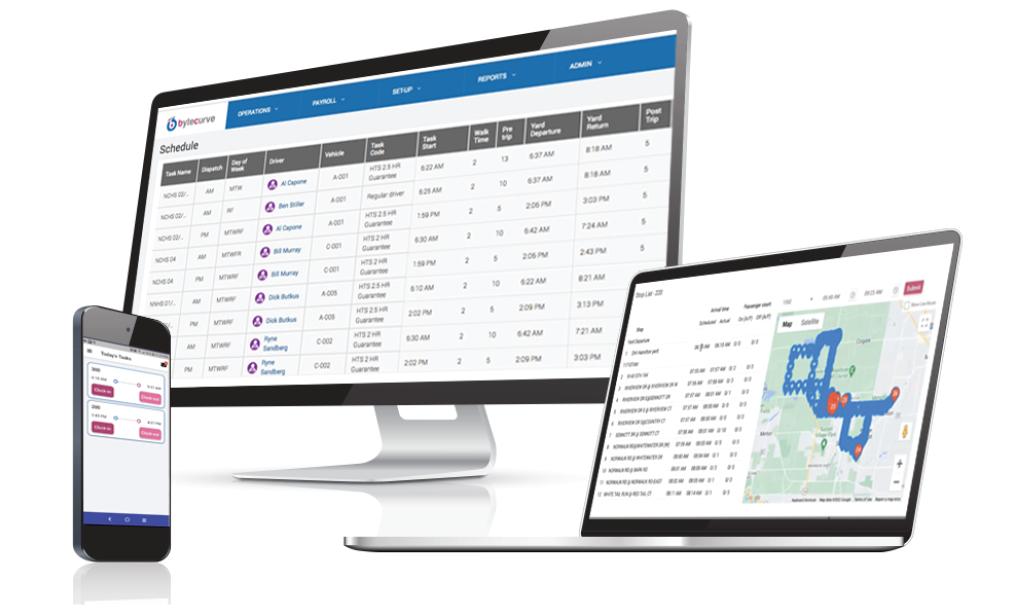
Streamlining Vehicle Maintenance and Operational Efficiency
One of the most significant advantages of Wi-Fi-enabled school buses is their ability to integrate predictive maintenance solutions.
Fleet management software powered by IoT technology provides continuous monitoring of critical vehicle components, allowing transportation departments to address maintenance needs before they become costly repairs.
Bytecurve360 and similar software solutions track engine diagnostics, fuel efficiency, and mechanical wear in real time. Automatic alerts detect issues and notify maintenance teams, thereby reducing downtime and preventing unexpected breakdowns. This proactive approach not only improves fleet reliability but also extends the lifespan of school buses, lowering long-term operational costs.
In addition to predictive maintenance, Wi-Fi-enabled school buses contribute to sustainability efforts.
Route optimization software minimizes unnecessary mileage and fuel consumption, reducing emissions and making school transportation more environmentally friendly.
These efficiencies align with many districts’ goals of transitioning to greener, more cost-effective transportation solutions.
Another major benefit is the ability to analyze performance data and make data-driven decisions.
Fleet managers can review historical trends, track fuel expenditures, and assess driver efficiency, allowing for continuous improvement in transportation operations.
The result is a more streamlined, cost-effective system that benefits both students and school districts alike.
The Future of Smart School Bus Technology
The continued advancement of Wi-Fi-enabled school buses represents a major step forward in modernizing student transportation.
As connectivity and IoT technology evolve, school districts will have even greater opportunities to enhance learning, improve safety, and optimize operational efficiency.
Future developments may include artificial intelligence-driven analytics to further refine route optimization, automated attendance tracking to streamline student monitoring, and expanded cybersecurity measures to protect sensitive data.
As more districts invest in these smart transportation solutions, the impact on education and safety will only continue to grow.
Ultimately, Wi-Fi-enabled school buses are transforming how students learn, how drivers operate, and how districts manage transportation fleets.
By leveraging advanced software solutions like Bytecurve360, school districts can create a more efficient, safer, and technology-driven approach to student transportation, ensuring that both learning and operational excellence move forward together.
Integrated Student Transportation Software
About Bytecurve
Founded in 2018 by GP Singh after many years on the frontline of student transportation operations with one of the country’s largest private student transportation providers, Bytecruve is designed as the 360 view of operations.
By blending routing and GPS fleet tracking data, and adding a payroll capability as well as mobile app for two-ways communications between dispatch and drivers, Bytecurve 360 has created a new category for student transportation excellence: the dispatch command center.
“We believe many school bus operators still don’t appreciate all the potential improvments they can deliver by taking two powerful yet independent systems and merging them into a new layer of visibility and action,” Singh said. “We’re integrated with all the major providers of routing systems and GPS fleet tracking so virtually any school district with both systems can take advantage of our transformative technology.”
Trusted by dozens of districts across North America, more than 40,000 school bus rely on Bytecurve technology to improve their efficiency and safety.
“I know from first hand experience what school bus fleet leaders need to perform at their best, and we work tirelessly on our product and with our customers to deliver this experience so they can know they are investing in the safest and most efficient fleet.”





